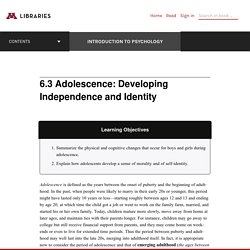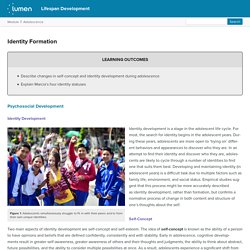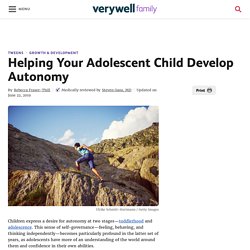

If you parents are baffled by some of your teenage child`s antics, just be assured that this is a period of self- exploration self-evaluation. They are in the process of creating their very unique and personal identity. 8 Stages of Development by Erik Erikson. Identity vs. Role Confusion. Erikson Stages of Psychosocial Development in Plain Language. Erik Erikson is one name you might notice come up again and again in the parenting magazines you leaf through. Erikson was a developmental psychologist who specialized in child psychoanalysis and was best known for his theory of psychosocial development.
Psychosocial development is just a fancy phrase that refers to how a person’s individual needs (psycho) mesh with the needs or demands of society (social). According to Erikson, a person passes through eight developmental stages that build on each other. 6.3 Adolescence: Developing Independence and Identity – Introduction to Psychology. Learning Objectives Summarize the physical and cognitive changes that occur for boys and girls during adolescence.Explain how adolescents develop a sense of morality and of self-identity.

Adolescence is defined as the years between the onset of puberty and the beginning of adulthood. In the past, when people were likely to marry in their early 20s or younger, this period might have lasted only 10 years or less—starting roughly between ages 12 and 13 and ending by age 20, at which time the child got a job or went to work on the family farm, married, and started his or her own family. Lifespan Development. Learning Outcomes Describe changes in self-concept and identity development during adolescenceExplain Marcia’s four identity statuses Psychosocial Development.

Read: How Parents Can Help Their Teens Develop Autonomy. Children express a desire for autonomy at two stages—toddlerhood and adolescence.

This sense of self-governance—feeling, behaving, and thinking independently—becomes particularly profound in the latter set of years, as adolescents have more of an understanding of the world around them and confidence in their own abilities. While every parent wants their child to grow in this way and doing so is important to living a happy and productive life as an adult, this transition often comes with some difficulties—both for sons and daughters as well as mothers and fathers.
Types of Independence Adolescents can become healthy, autonomous adults that are not controlled by other people or external forces through practicing autonomy in the following three ways: 5 Ways You Can Help Your Teen Create a Positive Identity.